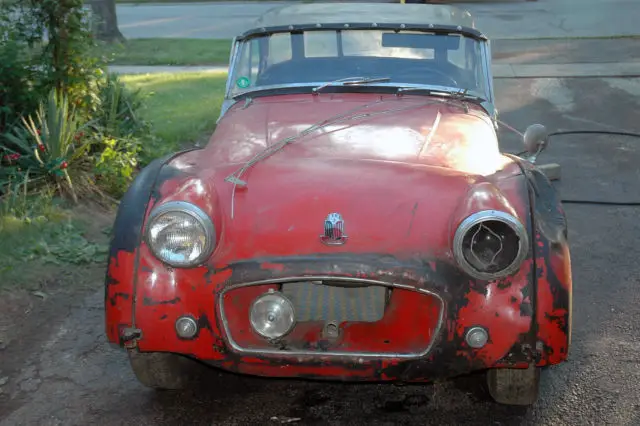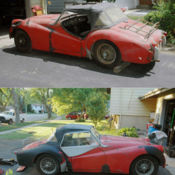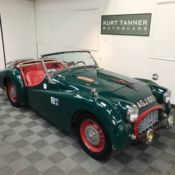1957 TR3 Roadster, Small Mouth: like a barn find, but not in a barn
| Condition: | Used |
| Make: | Triumph |
| Model: | TR3 |
| Year: | 1957 |
| Mileage: | 52,531 |
| VIN: | T5167912 |
| Color: | red |
| Engine: | gas |
| Fuel: | Gasoline |
| Drive type: | manual |
| Interior color: | black |
| Vehicle Title: | Clear |
| Item location: | Homewood, Illinois, United States |
| Extras |
|
Convertible |
| Listed by | Private seller |
Description of 1957 Triumph TR3 |
|
1957 TR3 Small Mouth Roadster Like a barn find, but not. I already knew it was there. Candidate for frame-off restoration. This is not one of those $30,000 show pieces, but it could be. More parts are available for these now, than when I was actively driving it 50 years ago. I’ve owned this TR since 1965 or 1966. It was garaged on blocks after 1973. I moved back here in 1996, and have never found time to work on this car. Body:There is rust. When I acquired this car, it had a bargain paint job and Bond-o covering a lot of rust. It has dents. A taxi hit the right rear in 1967, a 1969 Chevy backed over the left front fender in 1973. In the late 60s, friends with TRs used T6 Aluminum tread-plate to cover rusting floor pans. You can now get new replacement pans, which I would have done, if I ever had time and money to work on it. Another common malady was rusted escutcheons which mount the body to the frame near the wheels. This causes the back of the body to sag, and the passenger door will not close properly. The interior was recovered c. 1967. The jump seat in back may not be original and appears to be unique.There is no glove box. The box was fiberboard, and they usually deteriorate. The glove-box door has an oil temp gauge mounted in it, so the door can’t be used. I may have an extra glove-box door. The original interior color appears to be red, but it had been dyed black long before I bought it. Original body color appears to have been white. The seat covers appear to be still in good shape, except there are 2 small cuts and a hole about the size of a quarter on the side of the passenger cushion. Battery box is rusted through, but this is another body panel which I believe is currently available. When I was in college, I worked as a mechanic and had access to a few things and services which were used in this car. Some parts came off cars that the garage raced (racing cars are stripped of unnecessary trim). Engine:The engine hasn’t turned since 1973, but it only had 6- or 7,000 miles on a total rebuild. The rebuild reflected what I learned from the cars my employer raced.Crankshaft, flywheel, competition clutch assembly were dynamically balanced. Flywheel has been lightened. Con rods were magnafluxed, checked for straightness, and shot-peened to strengthen.The pistons and liners are what’s called a “2.2 Kit.” Original 83mm pistons gave a stock TR 1991cc displacement. The 2.2’s 87mm pistons yield 2197cc. The head was mill .080" to increase compression. Combustion chambers were smoothed, and the center edges chamfered to eliminate hot spots. The intake and exhaust ports were smoothed, but not polished. About all that separates this from a racing engine is the lack of a tuned exhaust manifold, and better carbs. The muffler came from a TR4 which was raced by that garage. The valve train (valves, springs, pushrods) are all Iskenderian competition, which should allow a 6000+ rpm red line. The cam is not Iskendarian, but was cut for me by Effingham Machine to yield a power range between 3500-6500rpm. Theoretical top speed would be 130-135, but not with TR-3 aerodynamics, and not on 60-year old tires. With this camshaft, valve clearances need to be greater than factory settings. I think it’s supposed to be .018", but it might be greater. I misplaced the specs from Effingham. Best to check what they are set at now, which could be correct.This is high-compression engine requires high octane fuel, and probably will need a lead-substitute additive.Fuel Tank:When the original leaked, I found a replacement. I can’t tell it’s current condition. The gas which was in the tank has long since dried up, probably leaving a glaze or residue. The original tank is also available, which after 50 years without petrol in it, would be safe to braze or solder, and the tank could be relined with epoxy. Radiator:The original leaked in 1966, but I found a replacement. It’s a racing core (40 cooling tubes instead of the factory 28), which has no hole for the cranking handle. You wouldn’t want to hand crank an engine with this much compression. The engine has also has an oil cooler. (I may also still have the original leaky rad.) Brakes:I removed the front calipers in 1974, and asked the garage where I used to work to rebuild them. Then I moved to California, leaving the car in my parent’s garage. When I returned, the garage had misplaced them. A few years ago, I found a set on E-bay, and purchased new pistons and seals for them from The Roadster Factory. But still never had time to work on the car. I forgot to photograph the calipers, but the rebuild stuff is pictured with the original grill. Wheels:Wire wheels with knockoffs. After I rebuilt the engine in ’73, I drove it from Illinois through Iowa, Kansas. Colorado, New Mexico (that’s where a drunk in ’69 Chevy backed over the left fender), Arizona, Nevada, California (through the Mojave to LA, up to SF, Mt. Shasta), and back. Some of the way, on Route 66. In LA, one of the wire wheels started breaking up. I found a replacement in a So. San Francisco salvage yard. On the way back, one started breaking up in Missouri. I found another replacement in Springfield. When I returned to Illinois, I acquired 2 spares which came off one of the cars that garage set up for racing. (No one raced with wire wheels, although they may do it now for vintage racing.) I don’t know which of the original wheels has not been replaced, or if I got 4 from the garage and replaced the two which hadn’t yet broken, Tires are Pirelli Cinturato steel-belted radials, which was the best tire for this car in 1965. The spare is a Dunlop bias-belted tire. Vintage tires should not be trusted at high speed. Other items:There is a choke cable added, connected to the throttle linkage. I used it as a poor man’s cruise control. I don’t have any records, but I think I got 37mpg on my cross-country trip, using this gadget to keep a steady speed. The car is mostly complete, except for some screws and bolts. A cover on a Dzus fastener for the spare tire compartment is missing. The bonnet hinges are broken, which make the bonnet easy to remove when servicing the engine. Captive nut cage for securing the cowl to the fenders were broken when trying to free rusted bolts, so the cowl is secured only by the brackets it fits into, and a couple of quick releases low on the fenders. Tools and accessories as shown in pics. The top was new in 1966, still in good condition. Two tonneau covers, one is ripped. New Aluminum side curtains were purchased in the 1960s, but I also have a few dilapidated sets of originals. There may be more extras here somewhere. I can’t remember where I put the ignition key. |
 Home
Home Contact us
Contact us NEWEST CARS
NEWEST CARS SELL YOUR CAR
SELL YOUR CAR FAQ
FAQ




















